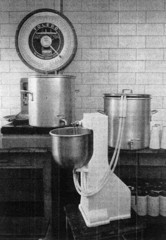The Invention of the Formula Diet: A Vital Tool for Metabolic Research and a Therapy for Patients With Digestive Disorders

Ahrens, Jr., Edward
Courtesy of the Rockefeller Archive Center
In the early 1950s, Edward H. Ahrens, Jr. (1915-2000) wanted to study the relationship between fat in the diet and atherosclerosis, the fatty deposits of cholesterol inside arteries that lead to heart attacks and strokes. He started clinical studies in which patients in the Rockefeller Hospital were fed standardized diets. But eating the same food every day became boring for patients who participated in weeks-long studies, and it was difficult to precisely control the balance of nutrients in the food. Then a pediatrician colleague advised Ahrens, "Feed them like babies. Feed them formula." Taking that lead, with colleague Vincent P. Dole, Ahrens created the first formula diets, an approach that soon became standard for studying not only heart disease, but also obesity, and many other aspects of metabolism.
With a formula diet, Ahrens could test the effects of changing different components in the diet with chemical precision. For example, keeping calorie levels constant, he could change the proportions of protein, carbohydrate, and fat. Critical to Ahrens interest in atherosclerosis, chemically defined diets also permitted him to vary the constituent fatty acids of the diet in ways not possible with ordinary foods, for example, by altering the unsaturation or chain length of the fatty acids. Eventually some 40 fats were tested in several hundred patients, leading Ahrens to the important finding that the degree of saturation of fat affects plasma cholesterol.

Equipment used for homogenization of formula in 40-kg batches
Ahrens proved the safety and utility of chemically defined formula diets in nutritional studies. In other early research, formula feeding was used to limit sodium in patients with hypertension, and to investigate dietary copper in Wilson's disease. Since then, formula diets have been used in many studies of human nutrition and as therapy for people who cannot eat or absorb a normal diet.
Edward H. Ahrens, Jr., received the BS (1937) and the MD (1941) from Harvard University. He joined the Rockefeller Institute in 1946 and was appointed professor in 1960. In 1982 he became the University's first Frederick Henry Leonhardt Professor. Ahrens was elected to the U.S. National Academy of Sciences, and he founded the Journal of Lipid Research. Throughout his career Ahrens advocated for patient-oriented research, and was known for his 1992 book, The Crisis in Clinical Research, which examined how medical science had moved toward laboratory research.
Selected Publications
Ahrens EH Jr, Dole VP, and Blankenhorn DH. The use of orally-fed liquid formulas in metabolic studies. Am J Clin Nutr, 1954, 2:336-342
http://www.ajcn.org/cgi/reprint/2/5/336
Ahrens EH Jr, Blankenhorn DH, and Tsaltas, TT. Effect on human serum lipids of substituting plant for animal fat in diet. Proc Soc Exp Biol Med, 1954, 86: 872-878
Ahrens EH Jr, Insull W Jr, Blomstrand R, Hirsch J. Tsaltas TT, and Peterson ML. The influence of dietary fats on serum-lipid levels in man. Lancet, 1957, 272:943-953
Further Reading
Ahrens EH Jr. After 40 years of cholesterol-watching. J Lipid Res, 1984, 25: 1442-1449
http://www.jlr.org/cgi/reprint/25/13/1442
Hirsch J. A Tribute to Pete Ahrens. J Lipid Res, 2001, 42: 891-893
http://www.jlr.org/cgi/content/full/42/6/891
Taubes G. The soft science of dietary fat. Science, 2001, 291: 2536-2545
Links
Rockefeller Archive Center, papers of Edward H. Ahrens, Jr.
http://www.rockarch.org/collections/ru/rgdescriptions.php
